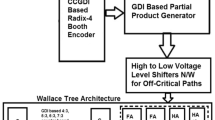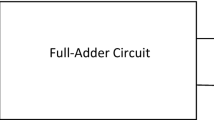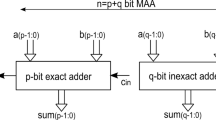Abstract
A low-power, high-speed \(4\times 4\) multiplier using Dadda algorithm is proposed. The full adder blocks used in this multiplier have been designed using reduced-split precharge-data driven dynamic sum logic. Flip flops used in the pipeline registers have been designed to increase input signal noise margin, resulting in the minimization of output signal glitches. The multiplier circuit is implemented in 1P-9M Low-K UMC 90nm CMOS process technology. Post-layout simulations are carried out using Cadence Virtuoso. The proposed multiplier operates at a clock frequency of 3.5 GHz, with an average dynamic power consumption of 1.096 mW at a temperature of \(27\,^{\circ }\hbox {C}\) and 1 V supply voltage and occupies a chip area of \(76\,\upmu \hbox {m}\times 102\,\upmu \hbox {m}\).


























Similar content being viewed by others
References
M. Aguirre-Hernandez, M. Linares-Aranda, CMOS full-adders for energy-efficient arithmetic applications. IEEE Trans. Very Large Scale Integr. (VLSI) Syst. 19(4), 718–721 (2011)
S. Agwa, E. Yahya, Y. Ismail, Variability Mitigation Using Correction Function Technique. in Proceedings of 20th ICECS, (Dubai, UAE, 2013)
M. Aktan, V.G. Oklobdzija, D. Baran, Multiplier Structures for Low Power Applications in Deep-CMOS. in Proceedings of ISCAS’11, (Rio de Janeiro, Brazil, 2011), pp. 1061–1064
Y. Bansal, C. Madhu, P. Kaur, High Speed Vedic Multiplier Designs A Review. in Proceedings of RAECS 2014, (Chandigarh, India, 2014), pp. 1–6
C.H. Bennet, Logical reversibility of computation. IBM J. Res. Dev. 6, 525 (1973)
K. Chong, T. Lin, Bah-Hwee Gwee, J.S. Chang, W.-G. Ho, Energy-delay efficient asynchronous-logic \(16\times 16\)-bit pipelined multiplier based on Sense Amplifier-Based Pass Transistor Logic. in IEEE International Symposium on Circuits and Systems (ISCAS 2012), (Seoul, Korea, 2012), pp. 492–495
M.P. Frank, Reversibility for Efficient Computing. Ph.D. dissertation, Department of Electrical Engineering and Computer Science, Massachusetts Institute of Technology, Cambridge, Jun 1999
A. Grover, G.K. Wadhwa, N. Grover, J. Gupta, Multipliers Using Low Power Adder Cells Using 180nm Technology. in Proceedings of ISCBI 2013, (New Delhi, India, 2013), pp. 3–6
M. Hansson, A. Alvandpour, N. Mehmood, An Energy-Efficient 32-bit Multiplier Architecture in 90-nm CMOS. in Proceedings of Norchip 2006, (Linköping, Sweden, 2006), pp. 35–38
S. Khan, S. Kakde, Y. Suryawanshi, VLSI Implementation of Reduced Complexity Wallace Multiplier Using Energy Efficient CMOS Full Adder. in Proceedings of ICCIC 2013, (Tamilnadu, India), pp. 1–4
K. Kuo, C. Chou, Low power and high speed multiplier design with row bypassing and parallel architecture. Microelectron. J. 41, 639–650 (2010)
M. Linares-Aranda, M. Aguirre-Hernandez, Energy-Efficient High-Speed CMOS Pipelined Multiplier. in Proceedings of CCE 2008, (Mexico City, Mexico, 2008), pp. 460–464
M. Margala, S. Purohit, Investigating the impact of logic and circuit implementation on full adder performance. IEEE Trans. Very Large Scale Integr. (VLSI) Syst. 20(7), 1327–1331 (2012)
P. Moallem, A. Vafaei, M. Ehsanpour, Design of a Novel Reversible Multiplier Circuit Using Modified Full Adder. in Proceedings of ICCDA 2010, (Qinhuangdao, Hebei, China, 2010), pp. V3-230–V3-234
B. Mukherjee, B. Roy, A. Biswas, A. Ghosal, Design of a Low Power \(4\times 4\) Multiplier Based on Five Transistor (5-T) Half Adder, Eight Transistor (8-T) Full Adder & Two Transistor (2-T) AND Gate. in Proceedings of C3IT 2015, (Kolkata, India, 2015)
D. Pal, M. Chandra, M.K.Goswami, A. Saha, Novel High Speed MCML 8-Bit by 8-Bit Multiplier. in Proceedings of ICDeCom 2011, (Mesra, Ranchi, India, 2011), pp. 1–5
D. Pal, M. Chandra, A. Saha, Low-power 6-GHz wave-pipelined 8b \(\times \) 8b multiplier. IET Circuits Devices Syst. 7(3), 124–140 (2013)
Y. Takahashi, T. Sekine, N. Anuar, \(4\times 4\)-Bit Array Two Phase Clocked Adiabatic Static CMOS Logic Multiplier with New XOR. in Proceedings of VLSI-SoC 2010, (Madrid, Spain, 2010), pp. 364–368
N. Weste, K. Eshraghian, Principles of CMOS Digital Design (Pearson Education, Indiana, 2002)
N.H.E. Weste, D.M. Harris, CMOS VLSI Design A Circuits and Systems Perspective (Pearson/Addison-Wesley, Boston, 2010)
Y. Yang, Z. Zhu, D. Zhou, Y. Yang, A High-Speed Asynchronous Array Multiplier Based on Multi-Threshold Semi-Static NULL Convention Logic Pipeline. in Proceedings of ASICON 2011, (Xiamen, China, 2011), pp. 633–636
R. Zimmermann, W. Fichtner, Low power logic styles: CMOS versus pass transistor logic. IEEE J. Solid State Circuits 32, 1079–1090 (1997)
Author information
Authors and Affiliations
Corresponding author
Rights and permissions
About this article
Cite this article
Shabbir, Z., Ghumman, A.R. & Chaudhry, S.M. A Reduced-sp-\(\hbox {D3L}_{\mathrm{sum}}\) Adder-Based High Frequency \(4\times 4\) Bit Multiplier Using Dadda Algorithm. Circuits Syst Signal Process 35, 3113–3134 (2016). https://doi.org/10.1007/s00034-015-0201-7
Received:
Revised:
Accepted:
Published:
Issue Date:
DOI: https://doi.org/10.1007/s00034-015-0201-7




